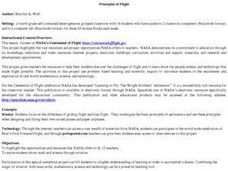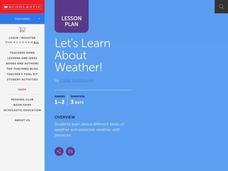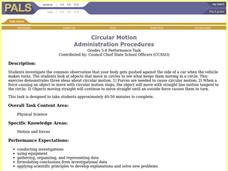Curated OER
Forces
Fourth graders review the meaning of Newton's 3rd Law and discuss the forces that are acting on a book setting on a table. They draw a diagram of the book on the table and use arrows to illustrate the direction the forces are acting.
Curated OER
Dayna Lykins, Leanna Prater
Fourth graders compare and contrast gliding flight and true flight. They investigate the basic principles of aeronautics. The class participates in activities to observe lift and the effect of air. Students design and fly their own...
Curated OER
Arthur's Teacher's Trouble
First graders are working on a literature focus unit based on Arthur's Teacher Trouble. The purpose of this language arts lesson is to strengthen observation skills.The teacher will explain the project to the entire class and be...
Curated OER
Let's Learn About Weather!
Students read several weather-related stories. They brainstorm weather words and use them as they make a weather booklet that includes pictures, a story of their own, and observations they make about the weather outside on that day.
Curated OER
Life Cycle of the Butterfly
Students observe and analyze the life cycle and metamorphosis of the Painted Lady Butterfly. They write observation journal entries three times a week and summarize what they observed. Using KidPix computer software they create pictures...
Curated OER
Wacky Water Critters
Students visit a local creek or stream. They collect water samples from the creek and observe and sort the "water critters" they find in the sample, observing smaller organisms under a microscope if necessary. They identify each organism...
Curated OER
Photograph / Special Object Worksheet
In this fieldwork application worksheet, students utilize a photo or object that they brought to class to study. Then they follow the directions on the worksheet and interview a classmate, using the 13 questions, about his or her photo...
Curated OER
Preparing a Louisiana Meal -- A Cloze Activity
In this Louisiana foodways worksheet, students give an accurate account of a meal preparation they observe in the classroom by filling in 39 blanks in an 8 paragraph account.
Curated OER
School Yard Park/Ecosystem
Fifth graders observe and categorize different sections of a park and it's ecosystem. In this categorizing lesson plan, 5th graders collect different facets of nature from a nearby park (without disturbing the ecosystem). They map,...
Curated OER
Capillary Action
In this capillary action worksheet, learners follow directions to see the ability of liquids being drawn up into small spaces using beakers, paper, rulers, food coloring and more. Students follow 8 sets of directions and write a conclusion.
Curated OER
Coordinate Seating: Using a Coordinate System
Fourth graders discover coordinate systems. In this mapping lesson, 4th graders create a coordinate system for theater seating. Students observe a video based on a theater's seating map.
Curated OER
The Contest Between the Sun and the Wind
Students investigate the relationship between the sun and wind. In this reading comprehension lesson, students read the book The Contest Between the Sun and the Wind, and observe the effect of the Sun and wind on our planet. Students...
Curated OER
Positive and Negative Charge Using Balloons
Fourth graders observe and explain how balloons rubbed on a shirt create positive and negative charges. In this positive and negative charge lesson plan, 4th graders record their results and explain their findings.
Curated OER
Applied Science - Science and Math Post-Lab
Students use scientific tools. In this Applied Science lesson, students investigate the use of scientific tools to enhance observation and discovery. Students indicate how each tool assists scientific work.
Curated OER
Science of Money
Students observe oxidation reaction in the lab using copper pennies. In this chemistry lesson, students examine a $1 dollar bill and record their observations. They explain how to identify counterfeit money using the iodine test.
Curated OER
Reading and Using a Recipe
Students explore how to follow a simple recipe and explain directions to another person.
Curated OER
The Earth is Tilted, What Does that Mean?
Students examine the tilt in the Earth's revolution around the sun. Using that information, they draw a picture and label the indirect and direct rays of the sun. In groups, they answer discussion questions and complete an assessment...
Curated OER
Sunlight and Plants
Students design and conduct an experiment to discover the role of direct sunlight on plants during germination and after germination. They plant corn and lima beans in small containers which they place in direct sunlight from a window...
Curated OER
Rice: The Global Crop
Students understand the uniqueness of the rice plant and how it grows. Students compare rice growing in Indonesia and California, observing the steps common to the process everywhere. Students comprehend the concepts labor-intensive and...
Curated OER
Natural Records of Change: Working with Indirect Evidence of Past Climates
Middle schoolers take part in a dice game to better explain the differences between direct and indirect evidence. They apply this knowledge to how scientists have used both types of evidence to determine how climate has changed over time.
Curated OER
Light Energy and Colors
Learners participate in experiments to observe the effects of light energy on colored objects. They conduct various experiments, create a graph and a word bank, record the results, and write an evaluation.
Curated OER
Land Use Issues
Learners observe and describe the properties of rocks and their significance relationship in the environment. They explain the implications of destroying habitats and the importance of rebuilding them.
Curated OER
Locomotor Dances
Students explore and perform locomotor movements. With partners, they combine the locomotor movements into a simple dance. The partner identifies three movements they observed. Students may be grouped into dancers for a performance.
Curated OER
Circular Motion
Students investigate circular motion in two different activities. In the first, students observe the path of a rolling marble on a paper plate. In the second, students play a game of catch using a tennis ball inside a plastic bag. ...
Other popular searches
- Euglena Direct Observation
- Eugenia Direct Observation
- Euglenda Direct Observation
- Glenda Direct Observation
- What Is Direct Observation

























